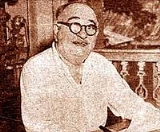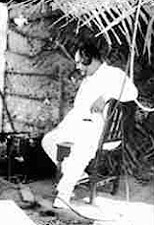
Ardeshir Irani
Encyclopedia
.jpg)
Telugu language
Telugu is a Central Dravidian language primarily spoken in the state of Andhra Pradesh, India, where it is an official language. It is also spoken in the neighbouring states of Chattisgarh, Karnataka, Maharashtra, Orissa and Tamil Nadu...
, English
English language
English is a West Germanic language that arose in the Anglo-Saxon kingdoms of England and spread into what was to become south-east Scotland under the influence of the Anglian medieval kingdom of Northumbria...
, German
German language
German is a West Germanic language, related to and classified alongside English and Dutch. With an estimated 90 – 98 million native speakers, German is one of the world's major languages and is the most widely-spoken first language in the European Union....
, Indonesian
Indonesian language
Indonesian is the official language of Indonesia. Indonesian is a normative form of the Riau Islands dialect of Malay, an Austronesian language which has been used as a lingua franca in the Indonesian archipelago for centuries....
, Persian
Persian language
Persian is an Iranian language within the Indo-Iranian branch of the Indo-European languages. It is primarily spoken in Iran, Afghanistan, Tajikistan and countries which historically came under Persian influence...
, Urdu and Tamil
Tamil language
Tamil is a Dravidian language spoken predominantly by Tamil people of the Indian subcontinent. It has official status in the Indian state of Tamil Nadu and in the Indian union territory of Pondicherry. Tamil is also an official language of Sri Lanka and Singapore...
. He was a successful entrepreneur who owned film theatres, a gramophone agency, and a car agency.
Life and career
Ardeshir Irani was born into a Zoroastrian family on 5 December 1886 in PoonaPune
Pune , is the eighth largest metropolis in India, the second largest in the state of Maharashtra after Mumbai, and the largest city in the Western Ghats. Once the centre of power of the Maratha Empire, it is situated 560 metres above sea level on the Deccan plateau at the confluence of the Mula ...
, Bombay Presidency
Bombay Presidency
The Bombay Presidency was a province of British India. It was established in the 17th century as a trading post for the English East India Company, but later grew to encompass much of western and central India, as well as parts of post-partition Pakistan and the Arabian Peninsula.At its greatest...
. In 1905, Irani became the Indian representative of Universal Studios
Universal Studios
Universal Pictures , a subsidiary of NBCUniversal, is one of the six major movie studios....
and he ran Alexander Cinema in Bombay with Abdulally Esoofally for over forty years. It was at Alexander Cinema that Ardeshir Irani learnt the rules of the art of filmmaking and became fascinated by the medium. In 1917, Irani entered the field of film production and produced his first silent feature film, Nala Dayamanti, which released in 1920.
In 1922, Irani joined Bhogilal Dave, the former manager of Dadasaheb Phalke
Dadasaheb Phalke
Dhundiraj Govind Phalke, popularly known as Dadasaheb Phalke was an Indian producer-director-screenwriter, known as the father of Indian cinema...
's Hindustan Films, and established Star Films. Their first silent feature film, Veer Abhimanyu was released in 1922 and starred Fatima Begum
Fatima Begum
Fatima Begum was one of the early superstars in Indian cinema and India's first female film director.-Family:Fatima Begum was born into an Urdu Muslim family in India in 1892. Fatima Begum was married to the Nawab of Sachin and was the mother of silent superstars like Zubeida, Sultana and Shehzadi...
in the female lead. Dave, a graduate of the New York School of Photography, shot the films while Irani directed and produced them. Star Films produced seventeen films before Irani and Dave dissolved the partnership.

In 1925, Irani founded Imperial Films, where he made sixty-two films. By the age of forty, Irani was an established filmmaker of Indian cinema. Ardeshir Irani became the father of talkie films with the release of his sound feature film, Alam Ara
Alam Ara
Alam Ara is a 1931 film directed by Ardeshir Irani. It was the first Indian sound film.Irani recognized the importance that sound would have on the cinema, and raced to complete Alam Ara before several contemporary sound films. Alam Ara debuted at the Majestic Cinema in Mumbai on March 14, 1931...
on 14 March 1931. Many of the films he produced were later made into talkie films with the same cast and crew. He is also accredited with making the first Indian English feature film, Noor Jahan (1934). He completed his hat-trick of earning fame when he made the first colour feature film of India, Kisan Kanya (1937). His contribution does not end only with giving voice to the silent cinema and colour to black-and-white films. He gave a new courageous outlook to filmmaking in India and provided such a wide range of choice for stories in films that till date, there are films being made which have a theme relating to one of the one hundred fifty-eight films made by Irani.
In 1933, Irani produced and directed the first Persian talkie Dokhtar-e-Lor
Lor Girl
Lor Girl was the first sound film ever to be produced in the Persian language. In 1932, it was produced by Ardeshir Irani and Abdolhossein Sepanta under the Imperial Film Company in Bombay....
. The script was written by Abdolhossein Sepanta
Abdolhossein Sepanta
Abdolhossein Sepanta was a noted Iranian film director and producer. He was born in Tehran, Persia, and died of a heart attack in Esfahan, Iran.-Early years:...
who also acted in the film along with members of the local Parsi community.
Irani's Imperial Films introduced a number of new actors to Indian Cinema, including Prithviraj Kapoor
Prithviraj Kapoor
Prithviraj Kapoor , 3 November 1906 – 29 May 1972) was a pioneer of Indian theatre and of the Hindi film industry, who started his career as an actor, in the silent era of Hindi cinema, associated with IPTA and who founded Prithvi Theatres, a travelling theatre company based in Mumbai, in...
and Mehboob Khan. He also interfered with the medium. He produced Kalidas in Tamil
Tamil language
Tamil is a Dravidian language spoken predominantly by Tamil people of the Indian subcontinent. It has official status in the Indian state of Tamil Nadu and in the Indian union territory of Pondicherry. Tamil is also an official language of Sri Lanka and Singapore...
on the sets of Alam Ara, with songs in Telugu
Telugu language
Telugu is a Central Dravidian language primarily spoken in the state of Andhra Pradesh, India, where it is an official language. It is also spoken in the neighbouring states of Chattisgarh, Karnataka, Maharashtra, Orissa and Tamil Nadu...
. Also, Irani visited London
London
London is the capital city of :England and the :United Kingdom, the largest metropolitan area in the United Kingdom, and the largest urban zone in the European Union by most measures. Located on the River Thames, London has been a major settlement for two millennia, its history going back to its...
, England
England
England is a country that is part of the United Kingdom. It shares land borders with Scotland to the north and Wales to the west; the Irish Sea is to the north west, the Celtic Sea to the south west, with the North Sea to the east and the English Channel to the south separating it from continental...
for fifteen days to study sound recording and recorded the sounds of Alam Ara on the basis of this knowledge. In the process, he created a whole new trend unknowingly. In those days, outdoor shootings were shot in sunlight with the help of reflectors. However, the outdoor undesirable sounds were disturbing him so greatly that he shot the entire sequence in the studio under heavy lights. Thus, he began the trend of shooting under artificial light.
Irani made one hundred fifty-eight films in a long and illustrious career of twenty-five years, between the First and Second World Wars. He made his last film, Pujari, in 1945. Irani was not compelled to live like Dadasaheb Phalke
Dadasaheb Phalke
Dhundiraj Govind Phalke, popularly known as Dadasaheb Phalke was an Indian producer-director-screenwriter, known as the father of Indian cinema...
for he realised that the war was a time not suitable for film business and therefore he suspended his film business during that time. He died on 14 October 1969 at the age of eighty-two, in Bombay, Maharastra.
As Director
- 1922 : Veer Abhimanyu- Silent
- 1924: Vir Durgadhar - Silent
- 1924: Paap No Fej - Silent
- 1924: Bombay Ni Sethani/Call of Satan - Silent
- 1924: Shahjehan - Silent
- 1925: Narsingh Dakoo - Silent
- 1925: Navalsha Hirji - Silent
- 1927: Wild Cat of Bombay - Silent
- 1931: Alam AraAlam AraAlam Ara is a 1931 film directed by Ardeshir Irani. It was the first Indian sound film.Irani recognized the importance that sound would have on the cinema, and raced to complete Alam Ara before several contemporary sound films. Alam Ara debuted at the Majestic Cinema in Mumbai on March 14, 1931...
- First Indian Talkie - 1937: Kisan KanyaKisan Kanya (1937 film)Kisan Kanya was a 1937 Hindi feature film which was directed by Moti B. Gidvani and produced by Ardeshir Irani of Imperial Pictures. It is largely remembered by the Indian public on account of it being India's first indigenously made colour film....
- First Indian Colour - 1937: "carlos"

